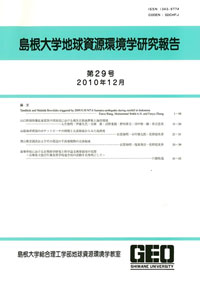島根大学総合理工学部地球資源環境学教室
ISSN:1343-9774

ダウンロード数 : ? 件
この文献の参照には次のURLをご利用ください : https://ir.lib.shimane-u.ac.jp/6131
島根大学地球資源環境学研究報告 22
2003-12-27 発行
Hydrothermal alteration at Crater Mountain, Papua New Guinea: Evidence from alteration mineral chemistry and lithogeochemistry
Shadrach K.Noku
赤坂 正秀
Roser BarryPaul
ファイル
内容記述(抄録等)
The Crater Mountain district of Papua New Guinea has been explored for precious metals since 1970.The latest phase saw the completion of seven exploration drill holes in 1999.The drill core consists of feldspar andesite,feldspar diorite,quartz-feldspar porphyry,hornblende-feldspar porphyry,lithic tuff,pyroclastics/breccia,and mud/siltstone.Hydrothermal alteration of these lithotypes has developed mineral assemblages composed of K-mica,carbonate(dolomite,ankerite,magnesite,and magnesian siderite),chlorite and pyrite.The abundance of hydrothermal chlorite is greater in the volcanic lithotypes,whereas K-mica(sericite),carbonate and quartz pseudomorhs are common in the intrusive rocks,particularly replacing primary ferromagnesian minerals.Accessory apatite and zircon are the only minerals which survive hydrothermal alteration.Fe and Mg contents ofK-mica decrease with increasing alteration(chloritization)representing changes in Na content to muscovite/sericite(K).
Immobile trace element ratios(Zr/TiO_2-Nb/Y)indicate most samples were originally of trachyandesite composition.All samples are hydrothermally altered to some degree and are enriched in SiO_2,K_2O,and Rb,and are depleted in CaO,Na_2O,MgO,Ba,and Sr.Elevated concentrations of MgO,Fe_2O_3 and K_2O coupled with low Na_2O and CaO values characterize chloritization.The pattern of low Na_2O,CaO and MgO values and high K_2O values are indicative of chlorite-sericite±quartz alteration.Values of the Ishikawa alteration index(AI)and the chlorite-carbonate-pyrite index(CCPI)become progressively greater passing from relatively less altered samples(AI=51−61;CCPI=62−66)to strongly altered samples (AI=42−98;CCPI=18−99).Zn is often elevated at AI values between 50 and 90,whereas Zn and As are enriched in samples with CCPI values between 55 and 75.Sr/Ba ratios are lowest at AI values above 90.The geochemical halo patterns and alteration mineral chemistry reflect the composite response of lithofacies to mineralogical and textural changes accompanying hydrothermal alteration associated with ore emplacement.
Immobile trace element ratios(Zr/TiO_2-Nb/Y)indicate most samples were originally of trachyandesite composition.All samples are hydrothermally altered to some degree and are enriched in SiO_2,K_2O,and Rb,and are depleted in CaO,Na_2O,MgO,Ba,and Sr.Elevated concentrations of MgO,Fe_2O_3 and K_2O coupled with low Na_2O and CaO values characterize chloritization.The pattern of low Na_2O,CaO and MgO values and high K_2O values are indicative of chlorite-sericite±quartz alteration.Values of the Ishikawa alteration index(AI)and the chlorite-carbonate-pyrite index(CCPI)become progressively greater passing from relatively less altered samples(AI=51−61;CCPI=62−66)to strongly altered samples (AI=42−98;CCPI=18−99).Zn is often elevated at AI values between 50 and 90,whereas Zn and As are enriched in samples with CCPI values between 55 and 75.Sr/Ba ratios are lowest at AI values above 90.The geochemical halo patterns and alteration mineral chemistry reflect the composite response of lithofacies to mineralogical and textural changes accompanying hydrothermal alteration associated with ore emplacement.
Other Article
PP. 93 - 105
PP. 107 - 110
PP. 111 - 120
PP. 121 - 133
PP. 161 - 166
PP. 167 - 172
